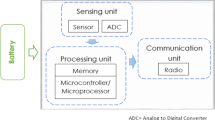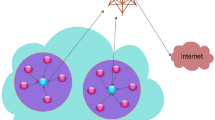Abstract
The objective of this paper is to develop a new adaptive iterative linear regression based clustering algorithm for wireless sensor network. According to this, the initial cluster is classified horizontally and vertically in parallel, each resulting in two sub-clusters. Of these two, the best is selected based on the proposed similarity index and with this selected cluster as reference, iteration continues until the convergence criterion ‘Delta’ is met. The similarity index is designed based on the intra cluster similarity and inter cluster dissimilarity. Delta is the difference between the similarity index of the current iteration and the previous iteration. The proposal is implemented in MATLAB and simulations are carried out under different network scenarios. The cluster quality is evaluated through external and internal indices using the Cluster Validity Analysis Platform tool. The cluster obtained by the proposal is studied and its quality is compared with the well-established k-means and hierarchical clustering. The performance indices confirm the supremacy of the proposal.









































Similar content being viewed by others
References
Akyildiz, I. F., Su, W., Sankarasubramaniam, Y., & Cayirci, E. (2002). Wireless sensor networks: A survey. Computer Networks, 38, 393–422. doi:10.1016/S1389-1286(01)00302-4.
Kumar, D., Aseri, T. C., & Patel, R. B. (2009). EEHC: Energy efficient heterogeneous clustered scheme for wireless sensor networks. Computer Communications. doi:10.1109/MWC.2004.1368893.
Al-Karaki, J. N., & Kamal, A. E. (2004). Routing techniques in wireless sensor networks: A survey. IEEE Transactions on Wireless Communication, 11, 6–28. doi:10.1109/MWC.2004.1368893.
Hemavathi, N., & Sudha, S. (2014). A fuzzy based predictive cluster head selection scheme for wireless sensor networks. In The proceedings of 8th International Conference on Sensing Technology & International Journal on Smart Sensing and Intelligent Systems, pp. 560–567.
Hemavathi, N., & Sudha, S. (2015). Hardware realization of fuzzy based cluster head selection in wireless sensor networks. In International conference on electronic design, computer networks & automated verification (2015).
Sasikumar, P., Khara, S. (2012). K-Means clustering in wireless sensor network. In Fourth international conference on computational intelligence and communication networks, pp 140–144. doi:10.1109/CICN.2012.136.
Amini, A., Wah, T. Y., & Saboohi, H. (2014). Density-based data streams clustering algorithms: A survey. Journal of Computer Science and Technology. doi:10.1007/s11390-013-1416-3.
Kumar, G., Mehra, H., Seth, A. R., Radhakrishnan, P., Hemavathi, N., & Sudha, S. (2014). An hybrid clustering algorithm for optimal clusters in wireless sensor networks. In IEEE students’ conference on electrical, electronics and computer science, pp. 1–6. doi:10.1109/SCEECS.2014.6804442.
He, H., & Qina, Z. (2010). K-Hyperplane-based neural network for non-linear regression. In Proceedings of 9th IEEE international conference on cognitive informatics, cognitive informatics (ICCI), pp. 783–787. doi:10.1109/COGINF.2010.5599808.
Shi, Y., Zhang, K., Liu, B., & Cui, L. (2011). A new QoS prediction approach based on user clustering and regression algorithms. IEEE International Conference on Web Services. doi:10.1109/ICWS.2011.95.
Ollos, G., & Vida, R. (2009). Adaptive regression algorithm for distributed dynamic clustering in wireless sensor networks. IEEE Conference on Wireless Days (WD). doi:10.1109/WD.2009.5449687.
Zhang, B. (2003). Regression clustering. In Proceedings of the third IEEE international conference on data mining (Icdm’03), pp. 451–458. doi:10.1109/ICDM.2003.1250952.
Liu, Z., Xing, W., Zeng, B., Wang, Y., & Lu, D. (2013). Distributed spatial correlation-based clustering for approximate data collection in WSNS. In IEEE 27th international conference on advanced information networking and applications, pp. 56–63. doi:10.1109/AINA.2013.26.
Zhang, B., Liu, Y., He, J., & Zou, Z. (2013). An energy efficient sampling method through joint linear regression and compressive sensing. In Fourth international conference on intelligent control and information processing (ICICIP), pp. 447–450. doi:10.1109/ICICIP.2013.6568115.
Weng, J., & Hwang, W.-S. (2001). Incremental hierarchical discriminant regression for online image classification. In IEEE sixth international conference on document analysis and recognition, pp. 476–480. doi:10.1109/ICDAR.2001.953835.
Shakibian, H., & Charkari, N. M. (2010). MCW: A new weighting method for linear combination of regressors in WSNS. In 5th international symposium on telecommunications (IST’2010), pp. 231–236. doi:10.1109/ISTEL.2010.5734029.
Halkidi, M., Batistakis, Y., & Vazirgiannis, M. (2002). Clustering validity checking methods: Part-I. ACM Sigmod Record, 31, 2.
Halkidi, M., Batistakis, Y., & Vazirgiannis, M. (2002). Clustering validity checking methods: Part-II. ACM Sigmod Record, 31, 3.
Xu, R., Xu, J., & Wunsch, D. C. (2012). A comparison study of validity indices on swarm-intelligence-based clustering. IEEE Transactions on Systems, Man and Cybernetics—Part B Cybernetics, 42, 1243–1256. doi:10.1109/TSMCB.2012.2188509.
Qiao, H., & Edwards, B. (2009). A data clustering tool with cluster validity indices. IEEE International Conference on Computing, Engineering and Information. doi:10.1109/ICC.2009.76.
Maulik, U., & Bandyopadhyay, S. (2002). Performance evaluation of some clustering algorithms and validity indices. IEEE Transactions on Pattern Analysis and Machine Intelligence, 24, 1650–1654. doi:10.1109/TPAMI.2002.1114856.
Author information
Authors and Affiliations
Corresponding author
Appendix
Appendix



Rights and permissions
About this article
Cite this article
N. Hemavathi, S. Sudha A Novel Regression Based Clustering Technique for Wireless Sensor Networks. Wireless Pers Commun 88, 985–1013 (2016). https://doi.org/10.1007/s11277-016-3226-8
Published:
Issue Date:
DOI: https://doi.org/10.1007/s11277-016-3226-8




